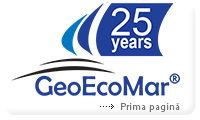| Short Name: GEOECOMAR |  |
| Country: Romania |
Description
Institutul National de Cercetare-Dezvoltare Pentru Geologie si Geoecologie Marina-Geoecomar is the National Institute for Research and Development of Marine Geology and Geoecology in Romania. It is an an R&D institute established in 1993, under the co-ordination of the Romanian Ministry of Research, focusing on the complex interactions of the Danube River – Delta – Black Sea macrosystem.
GeoEcoMar represents the focal point for national excellence in research and consultancy on marine, coastal, river and lacustrine geology, geophysics and geoecology, and is a reference centre for Marine and Earth Sciences. GeoEcoMar’s success, demonstrated by its technical capability and scientific performance, resulted in it becoming an “Institute of National Interest” in 1996.
The institute started cooperating internationally in the early 1990s with the first environmental assessment of the Danube River – Delta, under the coordination of the Cousteau Team, and has actively participated in the Framework Programmes (FP) of the European Union since FP4. First EC DG R&I funded project coordination: FP5 “Euro-EcoGeoCentre Romania”. In FP7 GeoEcoMar was involved in 13 projects: DANCERS (overall coordination), most relevant for this proposal being the Ias Eurofleets-1 and Eurofleets-2. In H2020 GeoEcoMar is general coordinator of DANUBIUS-Preparatory Phase and is currently involved in other 7 projects under the same programme. In regards to major Infrastructures or Integrated Actions for infrastructures, besides the overall leadership of DANUBIUS-RI, GeoEcoMar is partner in the HYDRALAB+ (previous HYDRALAB IV) and EMSO DEV and EMSO Link projects. GeoEcoMar also has a successful infrastructure collaborative activity in the Romanian – Bulgarian Cross Border Cooperation Programme (Projects HERAS, MARINEGEOHAZARD) and in other projects funded by DG REGIO, DG ENV and DG MARE.
GeoEcoMar has also been involved in major projects funded by the United Nations and IAEA Programmes for the Black Sea and Caspian Sea. The Institute has participated in numerous bilateral co-operation projects and in consultancy contracts with major private companies and administrations, performing environmental studies and dedicated works for resources in the Danube – Delta – Black Sea.
From 2006, the Institute has implemented a Quality Management System applied to geology, geoecology and geophysics. This has been authorized by Lloyd’s Register Quality Assurance (Romania), according to ISO
9001:2008 (SR EN ISO 9001:2008), approval certificate no. 170539 (2006 and certificate renewal in 2009, 2012, 2015).
Role
GEOECOMAR are involved in WP2 Transnational Access.
Access to Research Vessels and related infrastructure: RV Mare Nigrum [Regional].
GEOECOMAR will undertake activities in WP1 Project Management, WP5 Stakeholder Engagement, and WP8 Foresight: Legacy and Roadmap.
Assurance of the necessary capabilities for the interoperability of sea operations: a permanent relation with design companies and equipment manufacturers. A team of scientists with long experience from marine research cruises will be involved in the project. As RV operator, GeoEcoMar will have a technical team implied in the project. Assurance of good conditions for training on board of RV’s and acceptance of transnational access.
GeoEcoMar is one of the most important scientific operators for the Black Sea area. RV Mare Nigrum and the marine scientists teams operate in H2020, FP7,6, 5 projects (Eurofleets 1 and 2, Hypox, Up-grade Black Sea Scene, Sesame, PERSEUS, COCONET, ASSEMBLAGE, etc), in contracts with private companies (ExxonMobil, OMV- PETROM, Marexin BV, Peter Gas, Midia Resources), in the cross-border cooperation project (Marinegeohazard), dedicated to marine geohazards or in bilateral and national marine projects and programs dedicated to the geological, geophysical, geoecological and biological characteristics of the Black Sea.
Relevant Publications
-
Oaie, G., Melinte-Dobrinescu, M., 2012. Holocene lithological and biostratigraphical changes in the NW Black Sea. Quaternary International 261, p. 146-155;
-
Constantinescu, A.M., Toucanne, S., Dennielou, B., Jorry, S.J., Mulder, T., Lericolais, G. 2015. Evolution of the Danube Deep-Sea Fan since the Last Glacial Maximum: new insights into Black Sea water-level fluctuations. Marine Geology 367, 50–68.
-
Briceag, A., Ion, G., 2014. Holocene ostracod and foraminiferal assemblages of the Romanian Black Sea shelf. Quaternary International 345, 119-129.
-
Suaria, G., Melinte-Dobrinescu, M.C., Ion, G., Aliani, S., 2015. First observations on the abundance and composition of floating debris in the North-Western Black Sea. Marine Environmental Research 107, 45- 49.
-
Bajo M., Ferrarin C., Dinu I., Umgiesser G., Stanica A. 2014. Finite element hydrodynamic modelling of the Black Sea circulation near the Romanian coast and the Danube Delta. Continental Shelf Research, 78- 12 pp. 62-74.
